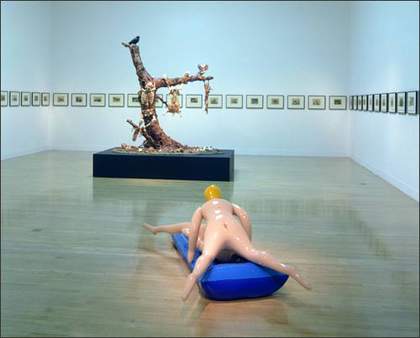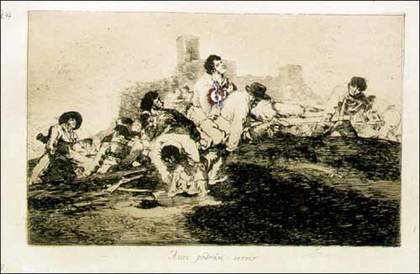
Jake and Dinos Chapman
Installation view with: (background) Insult to Injury 2003; (middle) Sex 2003; (foreground) Death 2003
Courtesy Jay Jopling/White Cube (London) © the artists
Jake and Dinos Chapman’s work
The Chapmans weave a vast range of associations into their work, using material from all areas of the cultural landscape including philosophical theory, art history and consumer culture. They engage with inflammatory subjects and use subversive strategies to produce works that defiantly refute straightforward interpretation.
The Chapmans first rose to prominence in the early 1990s with their three-dimensional recreations of Goya’s series of etchings, The Disasters of War. These depict atrocious acts of violence, carefully and playfully reconstructed with miniature and life-size figures. Subsequent works have continued to use the body as a way to explore an aesthetic of horror. Tragic Anatomies 1996 consists of a group of sexually-mutated child mannequins with genitalia sprouting from unlikely places, naked except for a pair of Nike trainers. With such works, the Chapmans challenge the very boundaries of taste, forcing the viewer into an uncomfortable position that fluctuates between child-like fascination and sheer revulsion.

Jake and Dinos Chapman
Insult to Injury 2003
Francisco de Goya 'Disasters of War', portfolio of 80 etchings reworked and improved
Courtesy Jay Jopling/White Cube (London)
Photocredit: Stephen White © the artists
The subversive wit and black humour that pervades the Chapmans’ works is undercut by the craftsmanship and painstaking labour evident in their execution; they are expert draftsman, engravers, model-makers and wood carvers. Hell 1999-2000 is arguably their most ambitious and excessive work. It is an enormous tableau in the shape of a swastika with over five thousand tiny Nazi figures acting out the roles of victim and executioner in an apocalyptic scene of death and destruction. In 1999 the Chapmans returned to Goya and published Disasters of War, a book of eighty-three hand-painted etchings based on the famous series. Recently, in Insult to Injury 2003, the artists have doctored a set of Goya’s etchings (printed in 1937) with hand-painted cartoon heads, breaking the ultimate artistic taboo through the desecration of a celebrated work.
Their recent exhibition, Works from the Chapman Family Collection 2002, paid ironic homage to the fast food giant McDonald’s through a fictional collection of rare ethnographic objects. The objects were carved from aged wood and presented in a parody of traditional museum displays. They appeared genuinely authentic until a closer inspection revealed the corporate symbolism of the hamburger chain. Issues of colonialism, capitalism, racism and globalisation are inherent in the work yet no critique or political statement is offered by the artists. Rather, the Chapmans’ aim is to unearth the contradictions and hypocrisies present in contemporary culture, posing questions but providing no answers.
